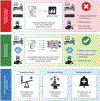Artificial Intelligence and Surgical Decision-making
- PMID: 31825465
- PMCID: PMC7286802
- DOI: 10.1001/jamasurg.2019.4917
Artificial Intelligence and Surgical Decision-making
Abstract
Importance: Surgeons make complex, high-stakes decisions under time constraints and uncertainty, with significant effect on patient outcomes. This review describes the weaknesses of traditional clinical decision-support systems and proposes that artificial intelligence should be used to augment surgical decision-making.
Observations: Surgical decision-making is dominated by hypothetical-deductive reasoning, individual judgment, and heuristics. These factors can lead to bias, error, and preventable harm. Traditional predictive analytics and clinical decision-support systems are intended to augment surgical decision-making, but their clinical utility is compromised by time-consuming manual data management and suboptimal accuracy. These challenges can be overcome by automated artificial intelligence models fed by livestreaming electronic health record data with mobile device outputs. This approach would require data standardization, advances in model interpretability, careful implementation and monitoring, attention to ethical challenges involving algorithm bias and accountability for errors, and preservation of bedside assessment and human intuition in the decision-making process.
Conclusions and relevance: Integration of artificial intelligence with surgical decision-making has the potential to transform care by augmenting the decision to operate, informed consent process, identification and mitigation of modifiable risk factors, decisions regarding postoperative management, and shared decisions regarding resource use.
Conflict of interest statement
Figures
Comment in
-
Reactive Artificial Intelligence Using Big Data in the Era of Precision Medicine.JAMA Surg. 2020 Jul 1;155(7):671. doi: 10.1001/jamasurg.2020.0839. JAMA Surg. 2020. PMID: 32374365 No abstract available.
-
Reactive Artificial Intelligence Using Big Data in the Era of Precision Medicine-Reply.JAMA Surg. 2020 Jul 1;155(7):671-672. doi: 10.1001/jamasurg.2020.0856. JAMA Surg. 2020. PMID: 32374380 Free PMC article. No abstract available.
References
-
- Raymond BL, Wanderer JP, Hawkins AT, et al. Use of the American College of Surgeons National Surgical Quality Improvement Program Surgical Risk Calculator during preoperative risk discussion: the patient perspective. Anesth Analg. 2019;128(4): 643–650. doi:10.1213/ANE.0000000000003718 - DOI - PubMed
Publication types
MeSH terms
Grants and funding
LinkOut - more resources
Full Text Sources
Medical




